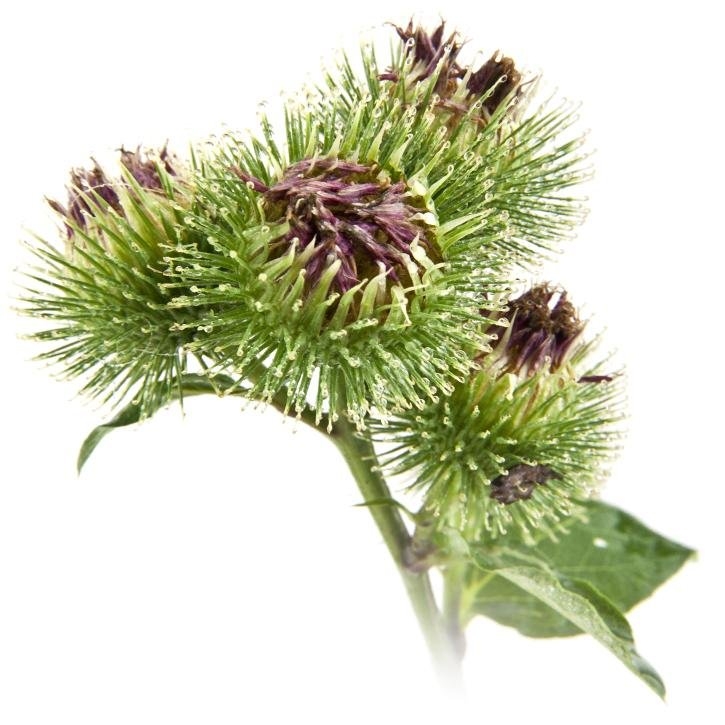Description
Biennial herbaceous plant, 80-150 cm high. During the first year, it only develops the root and the lower parts of it, giving rise to a rosette of big leaves. The second year the stem, flowers and fruit are developed. Whole big leaves, alternate, wide, with long petioles, almost entire and slightly toothed, heart-shaped or ovate. The back is downy, covered with a cloth of soft hairs spread on the surface. Lower leaves are very big and have laticiferous tubes with wide and stringed petioles, while the upper ones are smaller and oval-shaped. Inflorescences are pedunculate flower divisions that group together to form cymes. Flower heads are big, globose and glabrous. Tubular flowers in purple or violaceous-red in the upper edge, grouped in corymbs of little hooked prickles which adhere to everything with which they come in contact, and by attaching themselves to coats of animals are often carried to a distance. That is the way it can disseminate. It belongs to the Compositae family (Asteraceae).
As the Burdock grows freely in waste places and hedgerows, it can be collected in the wild state. It will grow in almost any soil, but the roots are formed best in a light well-drained soil. The harvesting must be done by the spring of the second year, before blooming, which takes place between July and September. This way the root will preserve its properties.
Part used
Burdock root (Arctium lappa L. = A. Majus Bernh.). Those from Lappa minor are used, too (Arctium minus Bernh. = Lappa minor Hill.) and/or Arctium tomentosum Miller. Sometimes leaves are used and very seldom fruits, too.
Indications
*Root
- Skin disorders: psoriasis, seborrheic dermatitis, skin impurities, sebaceous cyst, dermatosis, acne, furuncles, eczema, varicose ulcers, athlete’s foot, dermatomycosis, eruptive diseases (chicken pox, measles), etc.
- Gout and hyperuricemia.
- Genitourinary disorders, cystitis, uretheritis, urethritis, pyelonephritis (kidney infection) oliguria, renal lithiasis.
- Edemas, overweight with water retention, depurative cures.
- Fever.
- Hypertension.
- Hyperglycemia, type II diabetes, pre-diabetic patients with furunculosis, etc.
- Lack of appetite, hyposecreting dyspepsia, hepatobiliary dyskinesia
- Rheumatism (arthrosis, arthritis, etc.) rheumatic pains.
- Skin disorders, ulcers, wounds, furunculosis, itching, acne, abscesses, dermatomycosis, ichthyosis, psoriasis.
- Dandruff, scalp eczema, seborrhea, loss of hair (rubbing).
- In baths: improves toxins elimination throughout skin.
*Leaves
- Skin disorders: contusions, wounds, abrasion, chilblains, insect bites.
- It is very popular the use of fresh leaves juice applied as a compress or lotion on the scalp to prevent hair loss.
Bibliography
Herbal Drugs and Phytopharmaceuticals. Norman Grainger Bisset (Ed). Max Wichtl. CRC Press.1994.
Plantas Medicinales y Drogas Vegetales para infusión y tisana. Edición española a cargo de: Salvador Cañogueral, Roser Vila, Max Wichtl.1
Plantas Medicinales. Margarita Fernandez y Ana Nieto. Ed Universidad de Navarra. Eunsa 1982.
Fitoterapia: Vademecum de Prescripción. Plantas Medicinales. B. Vanaclocha, S. Cañigueral. Editorial Masson 4ª edición.
The Complete German Commission E Monographs. Therapeutic Guide To Herbal Medicines. Mark Blumenthal. American Botanical Council 1998.
Fitoterapia Aplicada. J.B. Peris, G. Stübing, B.Vanaclocha. Colegio Oficial de Farmacéuticos de Valencia 1995.
Plantas Medicinales. El Dioscórides Renovado. Pio Font Quer.
Jean Bruneton. Farmacognosia. Fitoquímica Plantas Medicinales. 2ª Edición. 2001. Ed Acribia. S.A.
100 Plantes Medicinales. Max Rombi. Romart 1998.
